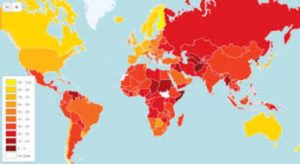Guest Post from Patrick Henz — Compliance Indicators
 I am proud to introduce Patrick Henz, a well-known compliance professional, as a guest contributor today. Patrick discusses measurements of corruption and appropriate compliance responses. Patrick can be reached at [email protected].
I am proud to introduce Patrick Henz, a well-known compliance professional, as a guest contributor today. Patrick discusses measurements of corruption and appropriate compliance responses. Patrick can be reached at [email protected].
Most compliance presentations and documents mention at some point the Transparency International Corruption Perception Index (CPI), as it is by far the best known corruption index. Of course, unlike weight, temperature or time, traditional measurement approaches cannot apply to corruption, as it always occurs behind closed doors. So for this index, Transparency International (TI) does not measure corruption levels, but instead examines how experts perceive it, focusing solely on public sector corruption, not bribery between two private companies. For their 2015 index, TI sourced and calculated data from 12 indices, provided by 11 different organizations, including the Bertelsmann Foundation Sustainable Governance Indicators, Freedom House Nations in Transit, Global Insight Country Risk Ratings, the World Economic Forum Executive Opinion Survey, and the World Justice Project Rule of Law Index.
Presenting one value for a whole country is, of course, a generalization; there can be significant differences among regions. There are other online sources to evaluate corruption levels, for example Harvard University’s Measuring Illegal and Legal Corruption in the American States and the National Survey on Governmental Quality and Impact (ENCIG), conducted by the Mexican Institute for National Statistics and Geography (INEGI).
Besides its renowned Corruption Perception Index, TI produces two other indices:
- Transparency International Bribe Payers Index (BPI): The BPI ranks 28 of the world’s largest economies according to the perceived likelihood of their companies’ payment of bribes abroad. Less well known than the CPI, the BPI is interesting because it shows how likely it is for a company to pay bribes outside its home country. It’s a fair assumption that companies first grow their business within their country of origin before expanding into other countries. The BPI reasons that if they use bribes outside their home territory, it is likely they first learned this “strategy” as a successful business behavior inside their home country.
- Transparency International Global Corruption Barometer (GCB): Unlike TI’s two other indices, the questionnaires for the GCB are not filled out by experts, but by everyday citizens, who should be representative of the total population.
TI has no monopoly on anti-corruption indices. Measurements from other organizations include:
- The TRACE Matrix: This measures business risk related to government anti-bribery laws and enforcement, local transparency and the capacity for civil society oversight.
- OECD Society at a Glance 2011: Different countries experience different levels of trust within their populations. According to this index, there is a statistical relationship between a society’s trust levels and its income distribution levels. A compliance organization has to be a “trusted advisor,” and this index can predict the degree of difficulty for it to be perceived as such.
- UDLAP Global Impunity Index 2015: This index by a Mexican university gives an important overview of responses to corruption in 59 countries. Being transparent is the first step for a region, but corruption should not only be detected, but also adequately addressed. To ensure a proper corporate culture, it is imperative that potential violations receive an appropriate response, related to the wrongdoing and not to the employee’s rank within the organization. No one should be above the internal guidelines. If employees do not believe this, they will not perceive compliance as a partner.
- Global Peace Index 2015: The Institute for Economics and Peace developed this index based on 23 qualitative and quantitative indicators.
- Business Anti-Corruption Portal: Not an index, but rather a comprehensive portal with information about most countries, including levels of business corruption and the legal environment.
- 2016 World Press Freedom Index: Freedom of press means freedom of information and ensures the quality of information. This annual index is produced by the France-based non-governmental entity “Reporters Without Borders” (“Reporters Sans Frontières” in French). Relevant topics are pluralism, media independence, media environment, self-censorship, legislative framework, transparency and the quality of the infrastructure.
- Spring 2015 Global Attitudes Survey: The US Pew Research Center publishes this annual survey, offering insights on the average person’s opinions and attitudes, which help fine-tune local compliance systems. Levels of optimism, externally or internally justified reasons for success, or support for the free market can determine potential behavior and identify compliance risks, such as ethical blindness or usage of a whistle-blower hotline.
 Depending on a company’s risk profile, different aspects of this freely available data can be used as indicators for the dashboard of an individual compliance system. But remember that these indices should not just “measure” the risk, but should drive appropriate responses, both as prevention and detection.
Depending on a company’s risk profile, different aspects of this freely available data can be used as indicators for the dashboard of an individual compliance system. But remember that these indices should not just “measure” the risk, but should drive appropriate responses, both as prevention and detection.
Links:
- Transparency International Corruption Perception Index 2015: https://www.transparency.org/cpi2015/results#results-table
- Transparency International Bribe Payers Index 2011 : http://bpi.transparency.org/bpi2011/results/
- Transparency International Global Corruption Barometer 2013: http://www.transparency.org/gcb2013
- TRACE Matrix 2015: https://www.traceinternational.org/trace-matrix
- OECD Society at a Glance 2011: Trust: http://www.oecd-ilibrary.org/sites/soc_glance-2011-en/08/01/index.html;jsessionid=2k63o2ljqcudo.x-oecd-live-03?itemId=/content/chapter/soc_glance-2011-26-en&_csp_=7d6a863ad60f09c08a8e2c78701e4faf
- UDLAP Global Impunity Index 2015: http://www.udlap.mx/cesij/resultadosigi2015.aspx
- Global Peace Index 2015: http://www.visionofhumanity.org/#/page/indexes/global-peace-index
















1 Response
[…] for all Compliance employees. For this, it was a pleasure and honor to participate with a guest blog and write about the different available Compliance relevant […]